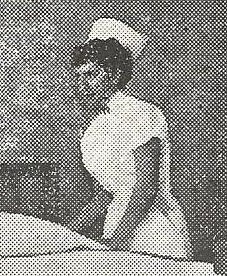Literature is filled with examples of "one hit wonders", first novels often very successful that are never followed by another work, at least not in the author's lifetime. One of American literature's examples is Margaret Mitchell's Gone with the Wind. A youthful novella was published long after her death; manuscripts of some other works were apparently destroyed. Ross Lockridge, Jr.'s Raintree County was the only novel he wrote; just as it became a best seller he committed suicide early in 1948. A film version with Elizabeth Taylor and Montgomery Clift was released in 1957. Ralph Ellison's Invisible Man is another notable American example. Anna Sewall's Black Beauty and Emily Bronte's Wuthering Heights are two well known titles from England.
An Alabama example is Red Bone Woman, the only novel published by Carlyle Tillery. Thomas Carlyle Tillery was born in Greenburg, Louisiana, on December 6, 1904. In 1928 he received a B.S. degree from Mississippi State University. For the next decade or more he worked as a statistical clerk in agricultural economics and spent two years as a timekeeper on a Central American banana plantation.
During World War II he served in the U.S. Army and his draft card, filled out on October 16, 1940, tells us a bit more about him. At the time he was living in Baton Rouge, Louisiana, and working for the Guaranty Income Life, Inc. company. He listed his weight as 160, complexion light, eyes blue, hair red and his height as 5' 6.5". He was apparently not married at this time, since he listed his sister as the person "who will always know your address." I found his card via Ancestry.com; you can see it below.
After his service in the military, Tillery next appears in Tuscaloosa, where he studied for three years under famed University of Alabama English and creative writing professor Hudson Strode. Did he come to Tuscaloosa to take Strode's classes? I have found no information about Tillery writing or publishing before or after his one published novel. Tillery apparently did not graduate from UA; I did not find him listed in a 2008 directory of university alumni.
On July 10, 1949, the following article appeared in the Tuscaloosa News [page 8]: "TUSCALOOSA STORE CLERK SIGNS CONTRACT FOR NOVEL: Carlyle Tillery Is Author Of 21st Book from Strode Class." The article noted Tillery as, "a kindly, quiet man, fortyish ,with rather sparse red hair, a freckled face, and glasses that hit a little farther down his nose than usual. On week days he ambles busily but unobtrusively up and down the aisles of Jitney Jungle Super Market No. 1 where he is employed in the stock room."
The Hoole Special Collections at the University of Alabama Libraries has some material on Tillery "most notably" the galley proofs of his novel. I am indebted to their online description for some of the information above.
At the time of his death Tillery was married to Ruby Wilson Tillery; you can see her photo below. I did not find marriage info for Ruby and Carlyle. I did find a reference to a Thomas C. Carlyle getting married on June 15, 1952 in Tuscaloosa County. Perhaps that is the date.
Ruby earned a nursing PhD in 1981. She was the author of "Differences in Perceived Relationships of Selected Components of Curriculum Implementation Prior to and Following Graduate Study by Louisiana Nurse Teachers Funded for Master's Level Study" which was her dissertation at the University of Alabama.
Carlyle Tillery died on January 23, 1988 in Tuscaloosa. An obituary published the next day in the Tuscaloosa News listed among his survivors wife Ruby, daughter Sarah and son Edward. Ruby died January 10, 2007, also in Tuscaloosa. She was 84, having been born November 23, 1922, in Woodville, Jackson County, Alabama. Memorial services for both were held at Forest Lake United Methodist Church, where they were presumably members.
As you can read below in the blurbs on the back of the paperback edition, Tillery's one novel received good notices. The "Literary Guidepost" review by W.G. Rogers [also below] declares, "Tillery is a name to add to the large list of distinguished southern writers."
So what happened? Where did Tillery's literary impulse come from and where did it go after publication of Red Bone Woman? Did he continue to work at Jitney Jungle until retirement? Perhaps one day a descendent will enlighten us.








































